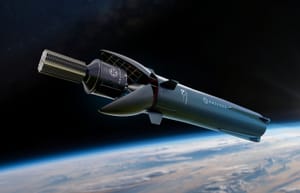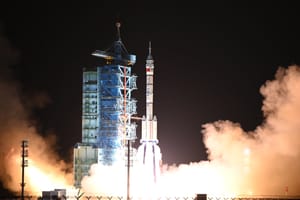
Jun 4, 2024
LandSpace's 'golden ticket' payload?
Disclaimer: This article contains the opinion and speculation of the writer and not Cosmic Nxws as a whole.
LandSpace, a commercial launch provider in China, and Hongqing Technology have recently filed with the International Telecommunications Union for a mega constellation via a joint venture called Shanghai LandSpace Hongqing Technology Co LTD. The filing via the joint venture lists the number of satellites for the constellation at ten-thousand across one-hundred and sixty orbital planes, these satellites would communicate in the Ka-band between each other and Earth.
This mega constellation, currently called Honghu-3, is believed to operate in low Earth orbit and provide internet and communication services to those on the ground below, similar to SpaceX's Starlink mega constellation, in coming years. Honghu-3 is the third proposal for a mega constellation in low Earth orbit from China, and the first not from a state-owned enterprise such as GuoWang and G60.
Shanghai Lanjian Hongqing Technology Company, commonly shortened to Hongqing Technology, is partnering with LandSpace to bring their expertise in spacecraft manufacturing, notably their Jinwu-200 krypton propellant Hall effect engine which has been conducting in-space tests since December 2023, to the mega constellation. LandSpace on the other hand will bring launch services to the mega constellation via its in-development Zhuque-3 launch vehicle, which is currently scheduled to debut in 2025. A partnership between the two companies was not unexpected as LandSpace holds a forty-eight percent stake in Hongqing Technology.
Potential benefits of Honghu-3
Depending on the fine details between the two companies, Honghu-3 can potentially become LandSpace's equivalent of Starlink. Starlink has allowed SpaceX to greatly increase the cadence of its Falcon 9 rocket over the past five years alongside decreasing its internal cost, which is thought to be under twenty million United States Dollars per launch.
LandSpace, like SpaceX, wants to operate a fleet of reusable first-stage boosters at a low cost and a high cadence. Zhuque-3 first-stage boosters are believed to be targeting twenty flights initially for a launch that could cost as low as 40,000 Yuan Renminbi per kilogram, which is approximately 5,500 United States Dollars, it is currently unclear if this is the cost a customer will pay or the internal cost. This cost is expected to go down as Zhuque-3 increases its cadence, it is also likely that LandSpace sells initial flights at a loss.
The partnership, and large stake, with Hongqing Technology, likely has LandSpace as the sole launch provider for the constellation. Being the sole launch provider would provide a significant boost to LandSpace's launch manifest, alongside launching parts of China's two other mega constellations, GuoWang and G60.
Details on the Honghu-3 satellites are very few currently, as such the size and mass of them are unknown to the public. At this time, it is difficult to pinpoint how many launches will be needed to bring the mega constellation to a capacity in which it is profitable. However like SpaceX's Starlink, it is thought that a few hundred launches will be needed, as 170 Starlink launches have occurred with 6,551 satellites placed into orbit since May of 2019.
Using Honghu-3 as a consistent and regular payload should allow LandSpace to comfortably increase the cadence of Zhuque-3, alongside lowering its cost over time as more first-stage boosters are built and reused.
Challenges ahead for Honghu-3
The largest challenge for Honghu-3 is that Zhuque-3 is yet to fly on its maiden launch, which is believed to be targeting mid-2025. LandSpace is seeking to bring as much commonality and pre-launch testing to Zhuque-3 as possible, by flying its engines on Zhuque-2 along with extensive testing of new components on the ground. Zhuque-3, and its components, will also feature a substantial amount of robotic automation in production which will remove human error from production, this also decreases workplace safety incidents as a side effect.
LandSpace may face a potential bottleneck with second-stage production while increasing launch cadence via Honghu-3 missions. The company is already scaling its engine production from thirty a year currently to one-hundred per year by 2025. Zhuque-3 using stainless steel for its tanks and structure also decreases complexity in manufacturing. They may also be exploring robotic production of propellant tanks so production can continue 24/7.
Hongqing Technology needs to further test its spacecraft components in-space ahead of launching the full constellation. The company is testing its Jinwu-200 krypton propellant Hall effect engine that will enable each spacecraft to perform maneuvers. They will also need to produce engines, solar panels, communications antennae, and possibly laser links at a consistent rate and quality for the mega constellation to operate effectively, they could also opt to buy these components instead.
Any plans or information around ground-based hardware have not been shared, one of the bigger obstacles Starlink had was the initial cost investment for customers to start receiving internet via the service. Honghu-3 may use a common ground-based antenna that will also be used by GuoWang or G60, but this remains to be seen.
What is Zhuque-3?
Zhuque-3 is LandSpace's in-development two-stage partially reusable medium to heavy lift launch vehicle targeting a debut in 2025. Zhuque-3 plans to burn liquid methane and liquid oxygen propellants in its engines on both stages, which will be built out of stainless steel.
LandSpace claims that Zhuque-3 will be able to lift up to 21,300 kilograms to low Earth orbit when expended, 18,300 kilograms when landing downrange on a drone ship or landing pad, or 12,500 kilograms when returning to the launch site.

The first-stage of Zhuque-3 is planned to be powered by nine TQ-12B engines generating an approximate combined 900 tons of thrust while burning liquid methane and liquid oxygen. LandSpace is also looking to fly each first-stage twenty times, with the potential to certify them for more flights.
The second-stage of Zhuque-3 is planned to be powered by one TQ-15B generating a believed 100 tons of thrust while also burning liquid methane and liquid oxygen.
To facilitate reuse of the first-stage, three engines will be lit during re-entry followed by one being lit again for landing on a drone ship or landing pad. For boost-back burns, the booster will turn around in-flight after separation and relight one engine.

The boosters and second stage are currently planned to have a diameter of 4.5 meters. The fairing is planned to be 5.2 meters in diameter and split into two halves. The total height of Zhuque-3 is currently planned to be 76.6 meters with it having a fully fuelled mass of approximately 660,000 kilograms.
Who is LandSpace?
LandSpace Technology Corporation is a Chinese private space launch provider based in Beijing and founded by Zhang Changwu in 2015.
The company launched its first rocket, Zhuque-1, on the 27th of October 2018 but failed to reach orbit. Zhuque-1 was a three-stage solid propellant rocket that was aiming to lift 300 kilograms into orbit until its cancellation in favor of Zhuque-2, which has so far launched three times with two successes. LandSpace has so far launched all of its rockets from the Jiuquan Satellite Launch Center, located in the Gobi Desert in northern China.
LandSpace is also actively developing Zhuque-3 for a maiden flight planned in 2025.




